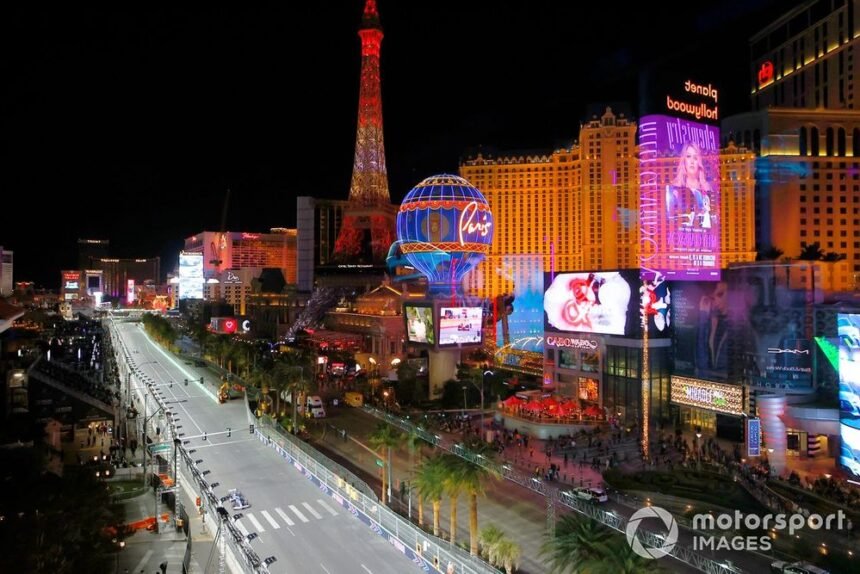“November in Las Vegas is typically the eighth-best month of the year; November last year was the second-best month in our history,” reveals Steve Hill, the president of the Las Vegas Convention and Visitors Authority in a statement hammering home the financial impact of Formula 1’s debut on the Strip.
With a promise that the concerns of the local community have been listened to and addressed in time for this weekend’s 2024 race, Vegas is once again ready to welcome the F1 circus into town with open arms.
Little wonder, given Hill’s explanation of just how big a splash the world championship made into the Bellagio fountains, a not insignificant drop into the vast ocean of money that Vegas brings in over the course of a year.
According to the Statista Research Department, Nevada-based casinos generated $10.92 billion during the 2023 fiscal year, so even in the relative slump of November, revenue is impressive. But F1 drove it to even greater heights.
“It turned what is one of the worst weekends of the year to one of the best weekends we’ve ever had, and that’s pretty phenomenal,” said Hill, pointing out that the Thanksgiving holiday, which was the week after the race, is notoriously a relatively fallow period for Vegas.
“What we’re all doing is trying to find that balance point with the sustainability of the race in Las Vegas, so that everybody involved is thrilled to have that.
“That’s really the definition, ultimately, of success. We’re not probably going to be able to compete with year one numbers again, and don’t need to in order for it to be successful.
“If the numbers were half that, it would still be a game-changer.
Esteban Ocon, Alpine A523
Photo by: Andy Hone / Motorsport Images
“The economic impact was the biggest we’ve ever had. The fiscal impact, the taxes generated by the race were the biggest thing that’s ever happened in Nevada. That matters.”
A debut race with a 10-month run-up, as tickets went on sale early to pull in as many fans as possible, clearly helped in making the 2023 race the single largest sporting event in Las Vegas history.
Over the course of the weekend, a reported 316,000 people passed through, resulting in an economic impact approaching $1.5 billion. Meanwhile, visitors to the race spent over $880 million, an average spend per person of more than three and a half times the typical Vegas visitor.
State, County and Local governments brought in tax totalling $77 million – much of which has since been invested into the community.
The race was huge not only financially but also in terms of media exposure for Las Vegas, with F1 fetching in 16.1 billion social media impressions with more media mentions across the race week than Vegas useless receives in a year.
“What we also got, which is something that is so valuable [was] eyeballs across the globe on Las Vegas,” added Hill.
“It was a multiple of what we typically get in a given year, all year, just on that race that weekend.
“That matters too and the celebrity aspect is a part of the draw; the visual is a part of the draw. Everything that happens on the Sphere goes viral, that was a really big part of the race.

Start action, Charles Leclerc, Ferrari SF-23 leads
Photo by: Erik Junius
“The attraction F1 brings to the city, we just can’t replicate. So it matters a lot to us.”
Changes have been made this year including a greater number of general admission tickets, a support race from Ferrari Challenge and the addition of an ice rink atop the Paddock Club.
Hill, though, is taking a realistic approach to year two and admits matching the revenue of the inaugural race is highly unlikely.
“We’re not going to get that on a regular basis, and I don’t think anybody should expect that,” he added.
“But if we can do something, we focus on trying to do something that moves the needle each week. We do that about half the weeks in the year and the other half it is just normally what happens in our city.
“This not only changes a week; it changes a month and there are not too many things that can do that. It’s going to do that again this year, probably not at the same level as last year, which is completely understandable. But every place [F1] goes, it’s such a big event that it makes a real difference, even in Vegas.
“We knew it would be big, but the attention [exceeded expectations]. And frankly, F1 did a fantastic job of building to that race.
“They’re doing it again this year and yes, it was two or three times more marketing value than we would have expected going in.
“We would have been happy with a third of what we got. I mean, we were going to be thrilled with what we expected, but what we got was eye-opening.”
Watch: The Driver-FIA Battle Intensifies and More – Autosport Answers Your Questions










